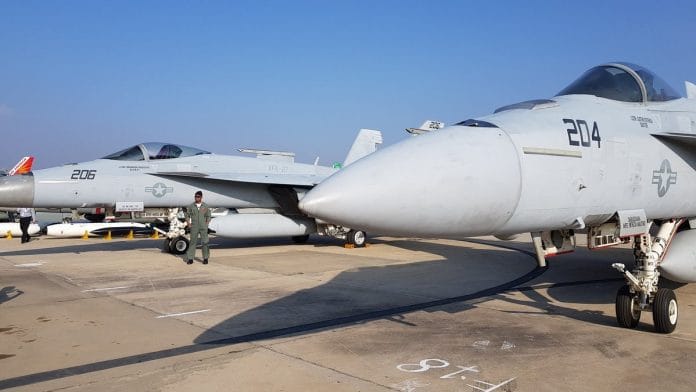New Delhi: Pitching its F/A-18 Super Hornets as the premier carrier aircraft in the world, US aviation major Boeing has said that their fighter offers more to the Indian Navy than competitor Rafale M by French firm Dassault Aviation.
Underlining that the Super Hornets are the US Navy’s clear choice for operations anywhere in the world, Torbjorn Sjogren, vice-president of international government and defence at Boeing, told ThePrint in an exclusive interview that the company has the right aircraft for both the Indian Navy and the Indian Air Force (IAF).
“I mean, it [Super Hornets] is well designed, well developed between the Echo (single-seater) and the Foxtrot (twin-seater). Both of those are operated by the US Navy and both, by the way, can operate for the Indian Navy, as opposed to our competitor, which obviously has a little bit of a challenge with regard to its two-seater,” said Sjogren, referring to the inability of the Rafale M twin-seater to operate from an aircraft carrier.
While the Rafale M already demonstrated its operational capability to the Indian Navy earlier this year, two Super Hornets are in the country currently for similar demonstrations. The Indian Navy, which originally wanted to procure 57 new fighters, is now looking to buy 27 — the competitors for the Naval contract are Boeing and Dassault Aviation.
Both companies have a significant presence in the Indian military.
The IAF operates both Rafale and Mirage aircraft manufactured by Dassault Aviation.
Boeing, too, has established a strong footprint in India, delivering 11 C-17 transport aircraft, 22 Apache attack helicopters, 12 P-8Is long-range maritime surveillance and anti-submarine warfare aircraft, besides 15 Chinook heavy-lift choppers.
They also delivered two 777 aircraft in 2020 for the VVIP fleet that is used to fly both the President and Prime Minister of India.
“Obviously, there are those additional six Apaches coming in for the Indian Army. We have a very big footprint there. And indeed, I think, if you were to tabulate things right now, Boeing continues to make up over 50 per cent of the current defence spending between the US and India. So, we are very proud of it. We have got a very strong foundation,” the senior Boeing executive said.
Also read: Boost for India’s plan to be aircraft maintenance hub as Navy planes get heavy work done in TN
‘Eager for Indian Navy’s assessment of Super Hornets’
Talking about the Super Hornets, Sjogren said that the US Navy continues to be very invested in the ‘Block III’ version of the aircraft, both through the service life extension programme as well as production.
“And when it comes to the US Navy, it is the expected aircraft for the force going forward. So, what’s number one [priority]? I would say the [Indian Navy’s] campaign, obviously. We have op demos going on,” he said.
According to Sjogren, Boeing is eager to get feedback from the Indian Navy on the Super Hornets’ strengths and weaknesses.
“We were very confident that when it comes to any mission and operation, the Super Hornet is the premier top carrier aircraft. When the US Navy needs to employ aircraft for missions, it goes to the Super Hornet every time,” he said.
The Super Hornets, added Sjogren, are significant since they are deployed when the US needs to bring mission readiness around the world.
“I don’t think that’s going to change in the near future. I think it is clear… aircraft are going to continue in production, also the US Navy is converting its aircraft to get a much longer service life. It’s going to continue for decades to come,” he said.
‘Navy and IAF joint acquisition could have been to Rafale’s advantage’
Talking about the Indian Navy’s earlier plan to work with the IAF for joint acquisition of fighters, Sjogren admitted that it would have been an advantage for Rafale.
“If they want to get the synergy of a collective buy, certainly that would favour the Rafale, because it’s currently an acquisition. But, to be brutally frank, equally, we think our products and the US armed services’ use of these products demonstrate why they are right. And certainly, when you look at the geopolitical scenario we live in today, these products are not going to sit on the ground,” he said.
The Indian Navy is now likely to pursue its independent fighter aircraft acquisition programme.
Boeing, Sjogren added, is confident that the experience and the record of the US Navy with the Super Hornet and the US Air Force with the F-15 and now with the F-15EX, as it’s going into production, provide a degree of mission readiness and proficiency that they believe matches the Indian requirements well.
(Edited by Zinnia Ray Chaudhuri)
Also read: Should India insist on large warships after sinking of Russia’s Moskva? The lesson not to take






